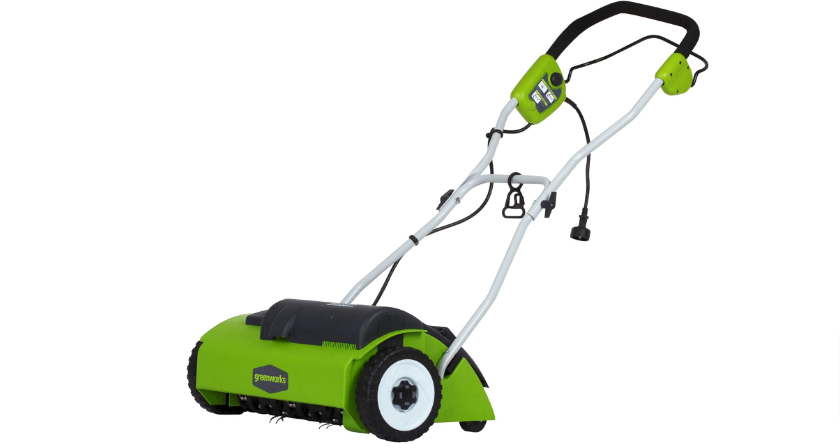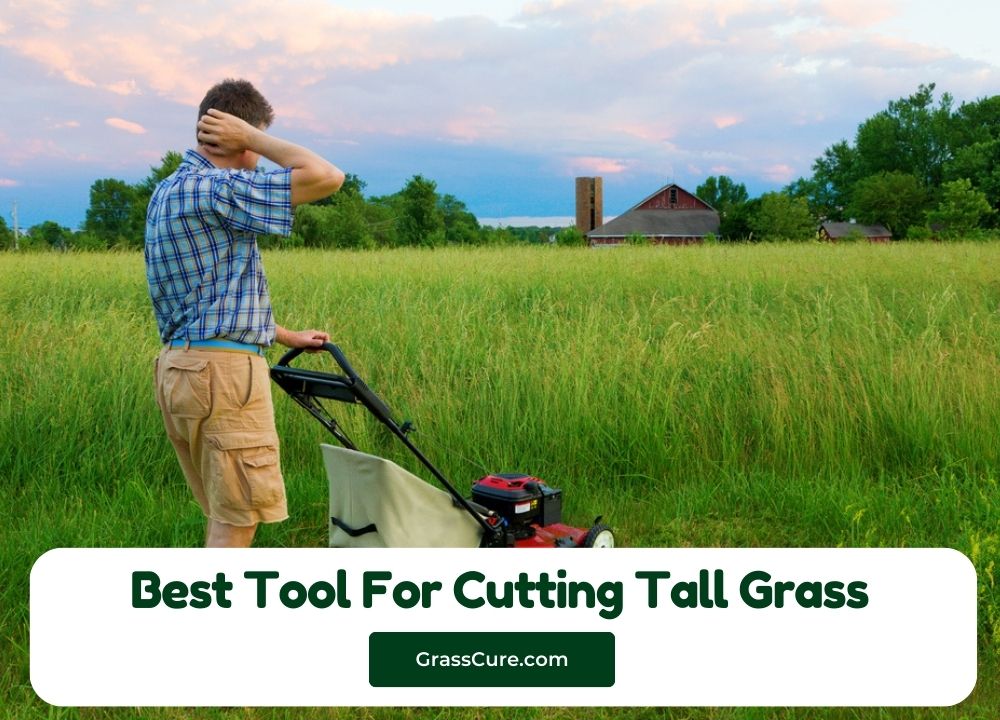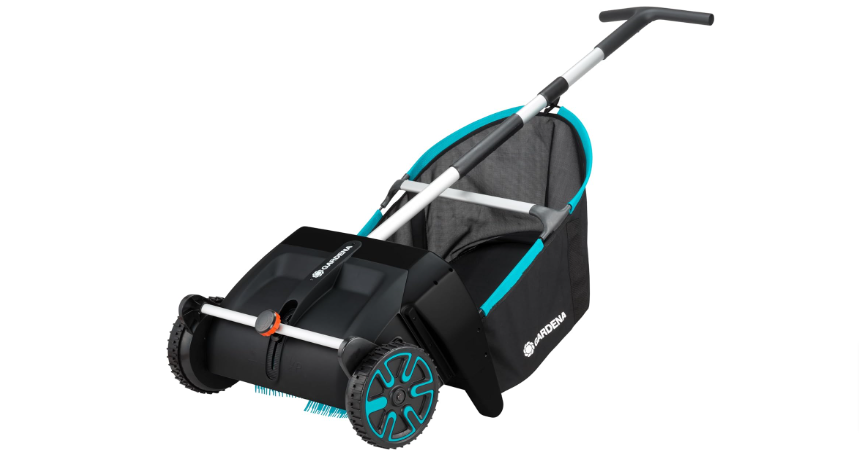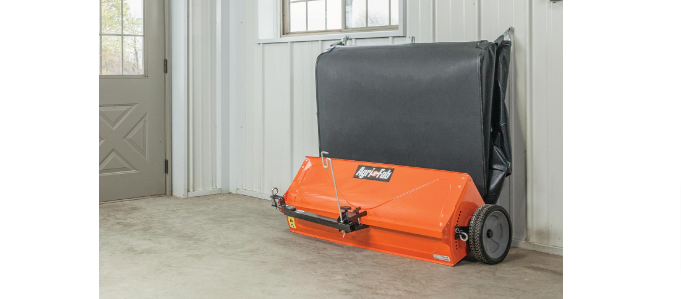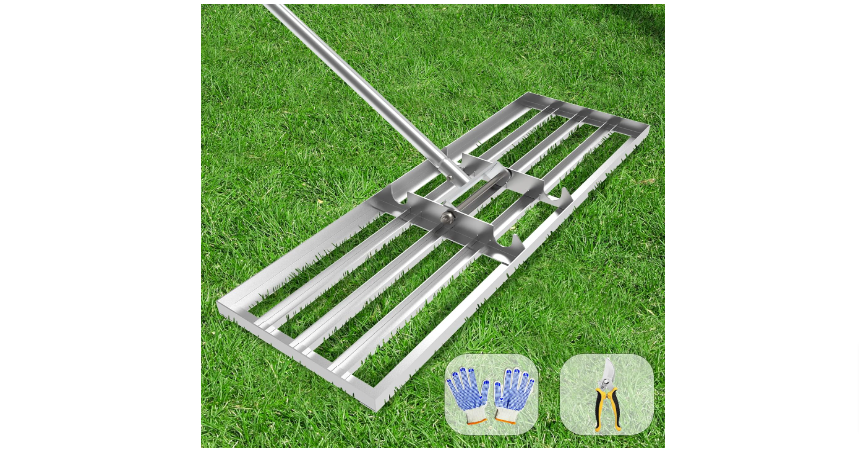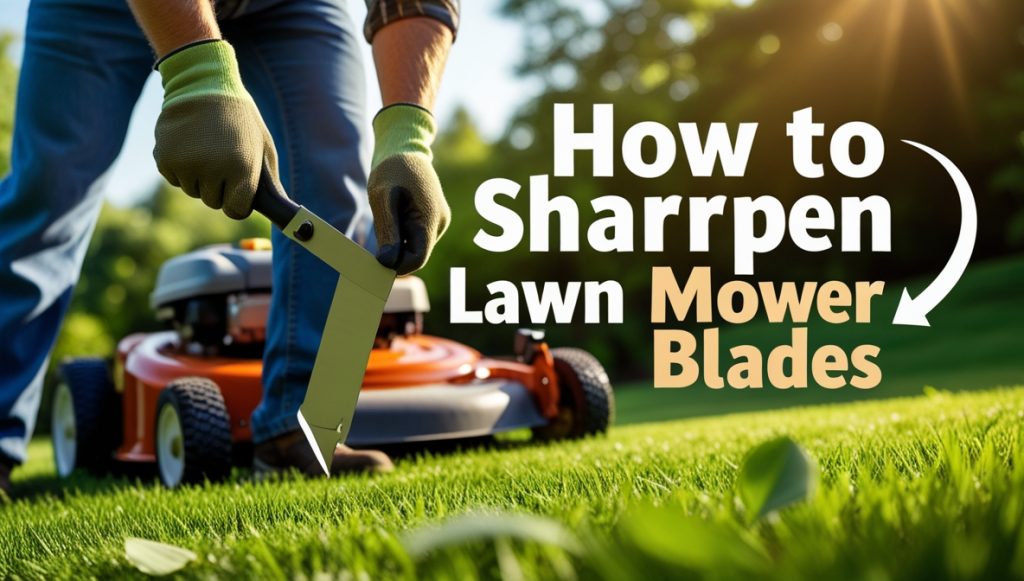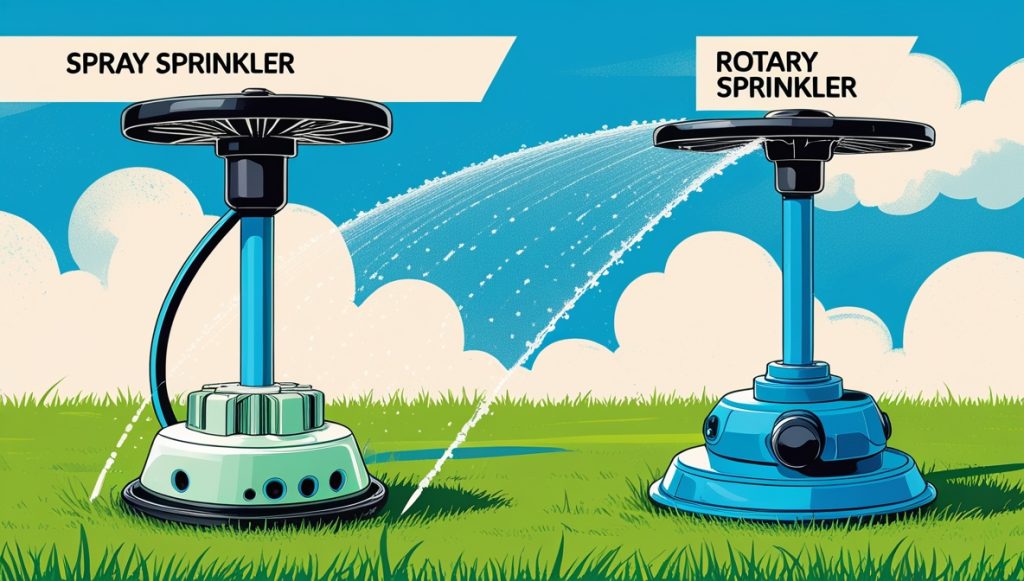Keeping your lawn lush and healthy requires more than just regular mowing and watering. Over time, dead grass, roots, and other debris can build up, forming a layer of thatch that blocks water, air, and nutrients from reaching the soil. This is where a lawn dethatcher comes in handy. A dethatcher helps remove thatch buildup, promoting better airflow and root development, giving your grass the chance to grow thicker and greener.
In this article, we’ll dive into why dethatching is crucial for lawn care and how choosing the best lawn dethatcher can make a big difference.
Contents
- Types of Lawn Dethatchers
- Key Features to Look for in a Dethatcher
- Top Lawn Dethatcher
- How to Choose the Right Dethatcher for Your Lawn
- Maintenance and Care Tips for Lawn Dethatchers
- Conclusion
- Frequently Asked Questions (FAQ) About Lawn Dethatchers
- Here are some references that can provide additional information and guidance about lawn dethatchers, their maintenance, and general lawn care:
Types of Lawn Dethatchers
Choosing the right type of lawn dethatcher depends on your lawn size, thatch buildup, and personal preferences. Let’s break down the three main types of dethatchers to help you find the best fit for your needs.
Manual Dethatchers
Manual dethatchers, often resembling a rake, are the simplest and most affordable option. They come with sharp metal tines that you manually pull through the grass to lift up the thatch. These are perfect for small lawns or minor dethatching jobs since they require a good amount of physical effort. If you have a small yard and don’t mind a bit of elbow grease, this option could be ideal.
- Pros: Inexpensive, no fuel or electricity needed, precise control.
- Cons: Labor-intensive and time-consuming; not practical for large lawns.
Electric Dethatchers
Electric dethatchers are lightweight machines that use a motor to power the tines, making them far easier to use than manual versions. They are ideal for small to medium-sized lawns and require little effort compared to manual dethatchers. There are both corded and cordless models available, with the corded ones being more powerful but limited by the length of the cord, while the cordless ones offer mobility but may need frequent battery recharges.
- Pros: Easy to use, great for medium lawns, lightweight, no emissions.
- Cons: Limited power compared to gas models, cord restrictions for corded models.
Gas-Powered Dethatchers
Gas-powered dethatchers are the heavy-duty option. These machines pack a lot of power and are suitable for larger lawns or those with significant thatch buildup. They have powerful engines, and unlike electric dethatchers, they aren’t restricted by cords or battery life. However, they are noisier, heavier, and require regular maintenance like oil changes and fuel refills.
- Pros: Best for large lawns, high power, no cord limitations.
- Cons: More expensive, heavier, noisier, requires maintenance.
Key Features to Look for in a Dethatcher
When choosing a lawn dethatcher, it’s essential to consider a few key features that can impact its performance and ease of use. Here’s what to keep in mind when shopping for the best dethatcher for your lawn.
Tine Types and Durability
The tines are the heart of a dethatcher, responsible for pulling up the thatch from your lawn. Look for sturdy, high-quality tines, preferably made of metal, as they are more durable and can handle tougher thatch. Plastic tines might work for light dethatching, but metal tines are a better long-term investment, especially if your lawn has thick or heavy thatch buildup. Also, ensure that the tines are easily replaceable, as they will wear down over time.
Adjustable Depth Settings
Thatch thickness can vary, so having adjustable depth settings on your dethatcher is crucial. This feature allows you to control how deep the tines penetrate the soil, ensuring you only remove the thatch without damaging your grass or soil. Depth control also enables you to customize the dethatching process based on the needs of different areas in your lawn.
Working Width
The working width of a dethatcher refers to the area it can cover in one pass. A wider working width means you can cover more ground faster, which is perfect for large lawns. However, if you have a small lawn or a yard with tight corners and obstacles, a narrower working width offers better maneuverability. Choose a width that matches your lawn size and layout for optimal efficiency.
Ease of Use
A dethatcher should be easy to operate, especially if you plan on using it frequently. Consider factors such as the machine’s weight, handle design, and overall maneuverability. Lightweight dethatchers are easier to push, especially on uneven ground, while ergonomic handles can reduce hand fatigue during longer sessions. Also, look for features like foldable handles or compact designs for easy storage when not in use.
Collection Bag or Debris Management
Some dethatchers come with a built-in collection bag or debris catcher, which can save you time and effort during cleanup. After dethatching, lawns are usually left covered in dead grass, leaves, and other debris. A dethatcher with a collection bag simplifies the process by gathering all the debris as you go, so you don’t need to rake afterward. However, keep in mind that collection bags can fill up quickly on larger lawns, so you might need to empty them often.
Top Lawn Dethatcher
Sun Joe AJ805E 15-Inch 13-Amp Electric Dethatcher and Scarifier
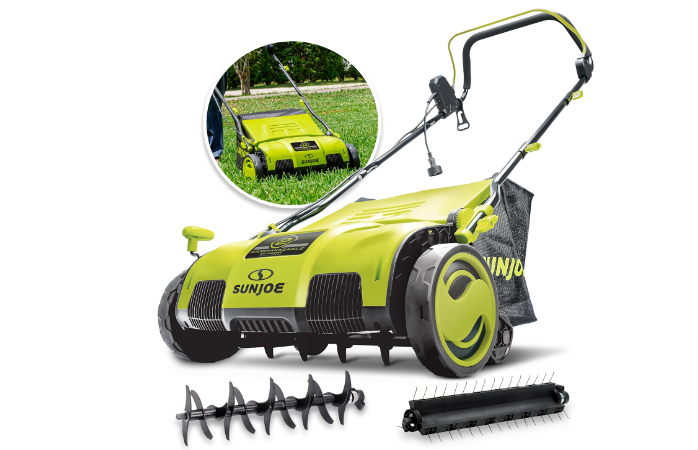
The Sun Joe AJ805E is a powerful electric dethatcher and scarifier designed to improve lawn health by removing thick layers of thatch and promoting better air, water, and nutrient absorption. It’s an excellent choice for homeowners with small to medium lawns looking for a convenient and efficient tool to manage lawn maintenance. Here’s a breakdown of its key features and performance.
Power and Performance
Equipped with a robust 13-amp motor, the Sun Joe AJ805E provides more than enough power to tackle heavy thatch buildup. The machine combines the roles of a dethatcher and scarifier, making it versatile for both loosening soil and removing dead organic matter. This dual functionality ensures that your lawn not only looks better but also becomes healthier by allowing grass roots to thrive.
15-Inch Working Width
The dethatcher features a 15-inch wide working path, which strikes a good balance between coverage and maneuverability. It allows you to cover medium-sized lawns efficiently without being too bulky or difficult to control. This width is ideal for homeowners who need to dethatch smaller yards or medium spaces, saving time compared to narrower models while still being easy to handle in tighter areas.
5-Position Height Adjustment
One of the standout features of the Sun Joe AJ805E is its 5-position height adjustment, which lets you control how deep the tines penetrate the soil. This versatility allows you to adjust the dethatching intensity to match the specific needs of your lawn. Whether you’re dealing with a light layer of thatch or a thicker buildup, you can fine-tune the height to get the job done without damaging the grass or soil beneath.
Airboost Technology
The machine is designed with Airboost technology, which enhances the performance of its steel tines. This technology helps increase the efficiency of thatch removal while boosting overall lawn health. The durable, spring-loaded steel tines are optimized to remove even stubborn debris, ensuring that your grass gets proper air, water, and nutrients to grow strong and lush.
Removable 13.2-Gallon Collection Bag
To make cleanup easy, the Sun Joe AJ805E comes with a 13.2-gallon collection bag that gathers the debris as you work. While the bag isn’t the largest on the market, it’s a handy feature that saves time by collecting the thatch and grass clippings, reducing the need to rake up the mess afterward. For smaller to medium-sized lawns, this capacity is generally sufficient, though you might need to empty it frequently on larger or more heavily thatched lawns.
Ease of Use and Maneuverability
Weighing in at just over 27 pounds, the Sun Joe AJ805E is relatively lightweight for an electric dethatcher, making it easy to maneuver around the lawn. The compact design and ergonomic handle ensure a comfortable experience, even for longer dethatching sessions. Additionally, being an electric model, it doesn’t require gas or oil, which simplifies maintenance and reduces overall operating costs. However, it is corded, so you’ll need an extension cord to cover larger areas.
Environmentally Friendly
As an electric dethatcher, the Sun Joe AJ805E is more environmentally friendly compared to gas-powered models. It produces zero emissions and is quieter during operation, making it a great option for neighborhoods where noise or air pollution might be a concern.
Pros:
- Powerful 13-amp motor for effective dethatching and scarifying.
- 5-position height adjustment allows for customized dethatching intensity.
- Airboost technology enhances performance and lawn health.
- Comes with a 13.2-gallon collection bag for easy cleanup.
- Lightweight and easy to maneuver.
- Environmentally friendly with no emissions or gas requirements.
Cons:
- The collection bag may require frequent emptying, especially on larger lawns.
- Corded design limits range and requires an extension cord.
The Sun Joe AJ805E 15-Inch 13-Amp Electric Dethatcher and Scarifier is an excellent tool for homeowners with small to medium lawns looking for an easy-to-use, effective dethatcher. Its powerful motor, adjustable height settings, and convenient collection bag make it a top choice for regular lawn maintenance. With Airboost technology and the option to scarify, it not only removes thatch but also revitalizes your lawn, promoting a healthier, greener yard.
Greenworks 13 Amp 14-Inch Corded Dethatcher/Scarifier (Model DT13B00)
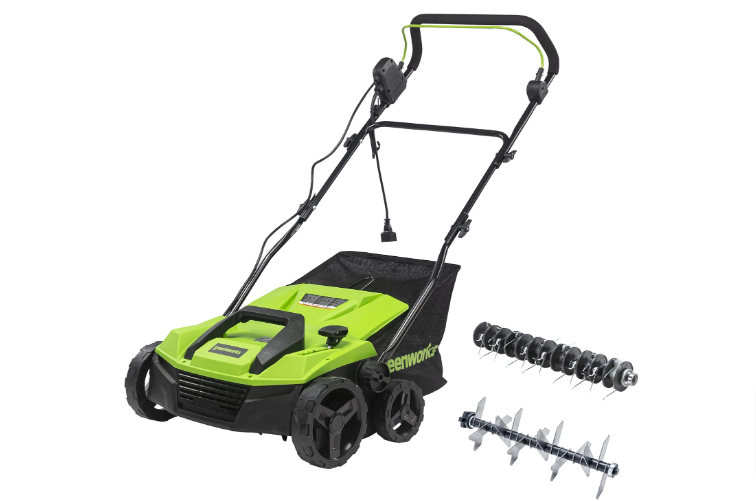
The Greenworks 13 Amp 14-Inch Corded Dethatcher/Scarifier is a powerful and affordable option for homeowners looking to keep their lawns in top condition. This model combines the capabilities of a dethatcher and scarifier, making it suitable for tackling thatch buildup and improving soil aeration. Below, we’ll explore the key features and benefits of this model to help you determine if it’s the right fit for your lawn care routine.
Powerful 13-Amp Motor
The Greenworks DT13B00 is equipped with a 13-amp motor, providing more than enough power to handle thick layers of thatch. Whether you’re dealing with small patches of thatch or more extensive buildup, the motor ensures a smooth, efficient dethatching process. This level of power puts it on par with other high-performance electric dethatchers, allowing you to remove organic debris without struggling through dense grass.
14-Inch Working Width
With a 14-inch working width, this dethatcher strikes a great balance between coverage and precision. It’s wide enough to handle medium-sized lawns efficiently, reducing the number of passes you need to make, yet narrow enough for easy maneuverability. This size is especially useful for smaller to medium lawns, as it allows for fast dethatching while still being easy to control in tight spots.
3-Position Depth Adjustment
The Greenworks dethatcher features three adjustable depth settings, enabling you to choose the level of thatch removal based on the condition of your lawn. Whether you’re dealing with light thatch or a heavier buildup, these settings allow you to customize how deep the tines go into the soil, giving you more control over the dethatching process and protecting your grass from damage.
Durable Stainless Steel Tines
The DT13B00 comes with stainless steel tines, which are both durable and rust-resistant. These tines are designed to withstand repeated use, even on lawns with tougher thatch. The stainless steel ensures that the tines maintain their shape and effectiveness over time, offering a long-lasting solution for your lawn maintenance needs. Additionally, the tines are replaceable, so you can easily swap them out when they start to wear down.
Corded Design
This Greenworks model is a corded dethatcher, which means you don’t have to worry about running out of battery or refueling like with gas models. However, the cord does limit your range, so you’ll need an extension cord to cover larger areas. While the corded design may restrict mobility slightly, it also ensures consistent power throughout your dethatching session, unlike cordless models that may experience battery drain.
Lightweight and Easy to Use
At approximately 25 pounds, the Greenworks dethatcher is relatively lightweight, making it easy to maneuver across your lawn without too much effort. Its compact design and ergonomic handle provide comfort during operation, which is particularly helpful during longer sessions. The lightweight nature also makes it easy to transport and store when not in use.
Environmentally Friendly
Since this dethatcher is electric, it produces zero emissions and runs quieter than gas-powered models. It’s a great option for those who want to minimize their environmental footprint while maintaining a healthy lawn. Additionally, there’s no need to worry about messy oil changes, fuel storage, or maintenance typically associated with gas dethatchers.
Pros:
- Strong 13-amp motor for effective dethatching and scarifying.
- 14-inch working width covers medium-sized lawns efficiently.
- 3-position depth adjustment allows for precise thatch removal.
- Durable stainless steel tines ensure long-lasting performance.
- Lightweight and easy to handle.
- Environmentally friendly with no emissions.
- Affordable compared to gas-powered options.
Cons:
- The cord limits range, requiring an extension cord for larger lawns.
- Lacks a collection bag, so additional cleanup is required.
Conclusion
The Greenworks 13 Amp 14-Inch Corded Dethatcher/Scarifier (DT13B00) offers excellent power and performance for homeowners with small to medium lawns. Its strong motor, adjustable depth settings, and durable stainless steel tines make it a reliable and efficient choice for removing thatch and promoting healthier grass growth. While the corded design may limit mobility, it ensures consistent power and is more environmentally friendly than gas-powered models. For those seeking a budget-friendly, effective dethatcher without the hassle of fuel or battery concerns, the Greenworks DT13B00 is a solid option.
Agri-Fab 40-Inch Tine Tow Dethatcher (Model 45-0294)
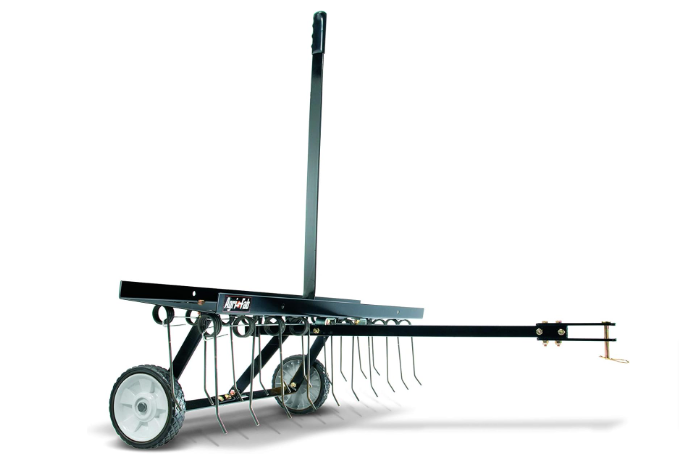
The Agri-Fab 40-Inch Tine Tow Dethatcher (45-0294) is a robust, tow-behind dethatcher designed for large lawns and heavy-duty thatch removal. This model is perfect for homeowners or landscapers with extensive properties that require regular dethatching, as it connects directly to your lawn tractor or riding mower. Its wide working width and durable construction make it ideal for efficiently covering large areas with minimal effort. Here’s a breakdown of its key features and what makes it stand out.
40-Inch Wide Working Width
One of the primary advantages of the Agri-Fab 45-0294 is its 40-inch working width, which allows you to dethatch large areas quickly and efficiently. This wide coverage significantly reduces the time spent on lawn maintenance compared to smaller, walk-behind dethatchers. It’s ideal for homeowners with expansive lawns, as it minimizes the number of passes needed to cover the entire area, making dethatching a much faster task.
20 Durable Heat-Treated Tines
This model is equipped with 20 heat-treated spring tines, which are designed for durability and effective thatch removal. These tines are made to withstand repeated use over large areas, and their spring design allows them to flex, making them more resistant to damage from obstacles like rocks or uneven terrain. The heat treatment also ensures that the tines remain sharp and effective over time, providing consistent performance year after year.
Tow-Behind Design
The Agri-Fab 45-0294 is a tow-behind dethatcher, meaning it attaches to the back of a lawn tractor or riding mower. This design allows you to easily pull the dethatcher across large lawns without the physical effort required by manual or walk-behind models. The tow-behind feature makes it a great choice for those who own riding mowers and need a reliable tool for maintaining large lawns, parks, or estates.
Adjustable Hitch for Easy Attachment
This dethatcher comes with an adjustable hitch, making it easy to attach to a variety of lawn tractors or riding mowers. The universal fit ensures compatibility with most standard hitch systems, so you won’t have to worry about whether it will connect to your current mower. The adjustable height also allows you to set the perfect level for your lawn, ensuring optimal dethatching without damaging the grass.
Transport Handle for Easy Operation
One of the convenient features of the Agri-Fab 45-0294 is its transport handle, which lets you raise or lower the tines without leaving the seat of your tractor. This allows you to quickly switch between dethatching and transport mode, making it easier to move across paved areas or other surfaces where dethatching isn’t needed. The handle gives you full control over when the tines engage the ground, providing added convenience during operation.
Rust-Resistant Finish
The dethatcher’s steel frame is coated with a rust-resistant finish, ensuring that it can withstand exposure to the elements and last for many seasons. This durability is especially important for outdoor tools that may face changing weather conditions and moisture from lawn treatments or irrigation systems. The heavy-duty construction also ensures that the dethatcher can handle the wear and tear of regular, long-term use.
Simple Assembly
Though it’s a large piece of equipment, the Agri-Fab 45-0294 is designed for simple assembly, allowing you to get it set up and ready to use without too much hassle. The included instructions are clear, and the necessary tools are typically easy to find, so you won’t need professional help to put it together.
Pros:
- Wide 40-inch working width for efficient dethatching of large lawns.
- 20 heat-treated spring tines for durable and effective thatch removal.
- Tow-behind design makes it easy to cover large areas without physical effort.
- Adjustable hitch ensures compatibility with most lawn tractors and riding mowers.
- Transport handle allows for quick adjustments between working and transport modes.
- Rust-resistant steel frame for long-lasting durability.
- Easy to assemble and use.
Cons:
- Requires a lawn tractor or riding mower, making it unsuitable for smaller lawns or those without the necessary equipment.
- May be less precise in small or tight areas due to its large size.
- No collection bag, so additional cleanup may be required after dethatching.
Conclusion
The Agri-Fab 40-Inch Tine Tow Dethatcher (45-0294) is an excellent choice for homeowners or professionals with large lawns or properties that need regular dethatching. Its wide working width, durable tines, and tow-behind design make it easy to cover expansive areas with minimal effort. While it does require a lawn tractor or riding mower to operate, the convenience and efficiency it provides make it a worthwhile investment for those with large lawns. If you’re looking for a heavy-duty dethatcher that can handle tough jobs and last for many seasons, the Agri-Fab 45-0294 is a top contender.
Brinly DT2-40BH-GA Premium Tow Behind Dethatcher, 40″
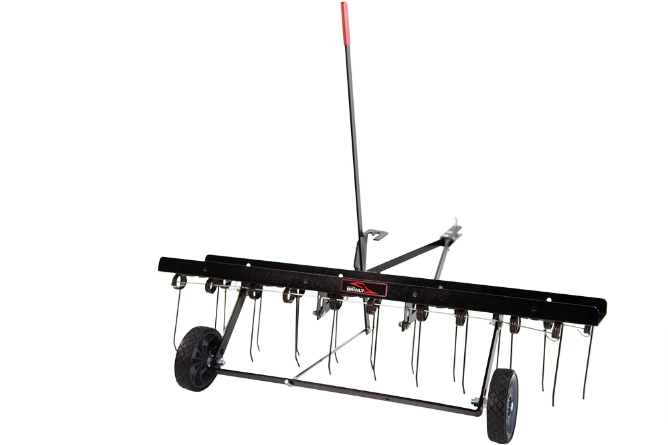
The Brinly DT2-40BH-GA Premium Tow Behind Dethatcher is a well-crafted tool designed to tackle tough thatch and improve the health of large lawns. Known for its sturdy build and reliable performance, this tow-behind dethatcher is ideal for homeowners with large yards who use lawn tractors or riding mowers. Offering a wide working path and premium features, the Brinly DT2-40BH-GA makes lawn maintenance efficient and manageable. Below, we’ll explore its key features to see if it’s the right fit for your dethatching needs.
40-Inch Wide Working Width
The 40-inch wide working width of the Brinly DT2-40BH-GA makes it highly efficient for covering large lawns. This wide path allows you to dethatch more ground in less time, cutting down on the number of passes needed to complete the job. For homeowners with expansive lawns, this is a major time-saver, making it an excellent option for anyone who needs to maintain a lot of grass without spending hours on manual labor.
24 Heat-Treated Steel Tines
This model features 24 heat-treated steel spring tines, which are designed for durability and long-term use. These tines are flexible yet tough, able to lift thatch without breaking or bending. The heat treatment strengthens the tines, ensuring that they stay sharp and effective over time, even in tough conditions or on uneven terrain. More tines mean more aggressive dethatching, ensuring that even heavily thatched areas are cleared efficiently.
Dual-Row Design for Enhanced Efficiency
Unlike some tow-behind dethatchers, the Brinly DT2-40BH-GA uses a dual-row tine design, which improves its overall effectiveness. With two rows of tines, the dethatcher provides more thorough coverage and better thatch removal with each pass. The two rows work together to grab and pull up thatch more effectively than a single-row design, ensuring your lawn is well-aerated and able to absorb nutrients, water, and sunlight more easily.
Transport Wheels with Adjustable Height
This dethatcher is equipped with 8-inch transport wheels that make it easy to move across driveways, sidewalks, or areas where dethatching isn’t necessary. The wheels are adjustable, allowing you to raise or lower the tines to the desired height with ease. This feature ensures that you can switch between transport and working modes quickly, protecting the tines and lawn from unnecessary damage when you’re not actively dethatching.
Tow-Behind Design
The Brinly DT2-40BH-GA is a tow-behind dethatcher designed to attach to your lawn tractor, riding mower, or ATV. Its universal hitch allows it to be compatible with most standard lawn equipment, making it simple to attach and start using right away. The tow-behind design is perfect for large properties, as it reduces physical effort and lets your tractor do most of the work.
Heavy-Duty Steel Frame
This dethatcher is built with a heavy-duty steel frame, giving it the strength needed to withstand the demands of heavy thatch removal. The sturdy construction not only enhances the overall durability of the machine but also ensures it stays stable during operation, even on uneven ground. The steel frame helps the unit stand up to long-term wear and tear, making it a reliable choice for serious lawn care enthusiasts.
Weight Tray for Added Performance
The Brinly DT2-40BH-GA features a built-in weight tray, which allows you to add up to 70 pounds of extra weight. This is particularly useful if you need more tine penetration for thicker thatch or more compact soil. Adding weight helps the tines dig deeper into the lawn, ensuring better results, especially in heavily thatched or compacted areas.
Simple Assembly
Brinly is known for providing easy-to-follow instructions, and the DT2-40BH-GA is no exception. While it is a larger piece of equipment, assembly is straightforward, and most users can have it ready to go in a relatively short time with common tools. The simple setup means you can start dethatching sooner rather than later.
Pros:
- Wide 40-inch working width covers large areas quickly.
- 24 heat-treated steel tines for durability and effective thatch removal.
- Dual-row tine design ensures thorough dethatching in each pass.
- Adjustable transport wheels for easy mobility and height control.
- Universal hitch for compatibility with most lawn tractors and riding mowers.
- Heavy-duty steel frame for enhanced stability and durability.
- Weight tray allows for improved tine penetration in tough conditions.
- Easy to assemble and use.
Cons:
- Requires a lawn tractor or riding mower, which may not be suitable for smaller lawns.
- No collection bag, meaning debris cleanup will need to be done separately.
- Might be too large for smaller, tighter spaces or lawns with numerous obstacles.
Conclusion
The Brinly DT2-40BH-GA Premium Tow Behind Dethatcher is an excellent choice for homeowners or professionals with large lawns who want an efficient and durable dethatcher. Its wide working width, dual-row tine design, and heavy-duty construction make it ideal for heavy-duty dethatching on expansive properties. With added features like transport wheels and a weight tray, it offers flexibility and control, ensuring that your lawn gets the proper care it needs. While it does require a tractor or riding mower, it’s a great investment for anyone with significant lawn care needs. If you’re looking for a reliable, powerful, and time-saving solution for dethatching large areas, the Brinly DT2-40BH-GA is a standout option.
Greenworks 10 Amp 14” Corded Electric Dethatcher
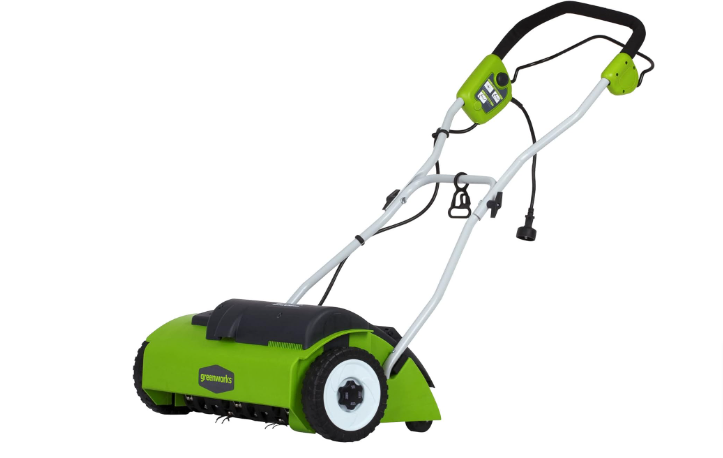
The Greenworks 10 Amp 14” Corded Electric Dethatcher is an efficient and user-friendly tool designed for homeowners looking to maintain the health and appearance of their lawns. Featuring stainless steel tines and a lightweight design, this dethatcher makes it easy to remove thatch and dead grass without the hassle of gas or battery power. Let’s dive into the key features, pros, and cons of this model to see if it fits your lawn care needs.
Powerful 10 Amp Motor
At the heart of the Greenworks dethatcher is its 10 amp motor, which provides ample power for removing thatch and debris. While it may not have as much power as some higher-amp models, the 10 amp motor is suitable for light to medium thatch removal, making it a great option for average-sized lawns. This electric motor means you can start working immediately without worrying about fuel or battery life, providing convenience and reliability.
14-Inch Working Width
The 14-inch working width strikes a good balance between maneuverability and coverage. It’s wide enough to tackle larger areas efficiently but compact enough to navigate smaller lawns and tight spaces. This width is ideal for homeowners who want to dethatch their yards quickly without the need for multiple passes, making lawn maintenance more manageable.
Durable Stainless Steel Tines
Equipped with stainless steel tines, this dethatcher is built for durability and performance. Stainless steel tines are not only resistant to rust but also designed to withstand the rigors of regular use. They maintain their sharpness longer than some other materials, ensuring effective thatch removal over time. The tines can penetrate the soil effectively, helping to promote better air and nutrient absorption for your lawn.
Lightweight and Easy to Maneuver
Weighing in at around 24 pounds, the Greenworks dethatcher is relatively lightweight, making it easy to maneuver around your lawn. Its compact design allows for comfortable operation, and you won’t tire easily during longer dethatching sessions. The lightweight nature also makes it easier to transport and store, which is a plus for those with limited storage space.
Ergonomic Handle
The dethatcher features an ergonomic handle that enhances comfort during operation. This design minimizes fatigue, allowing you to dethatch your lawn without straining your back or arms. The handle’s design also allows for easy control of the dethatcher as you navigate around your yard, giving you better precision and maneuverability.
Corded Design
The corded design of this dethatcher ensures you won’t have to worry about battery life or refueling like with gas models. While this limits your range to the length of your extension cord, the consistent power supply means you can work without interruptions. Just be sure to have a long enough extension cord to reach all areas of your lawn, and you’ll be good to go!
Easy-to-Use Controls
Greenworks has designed this dethatcher with user-friendly controls, making it accessible even for those new to lawn care. The simple operation means you can quickly get started on dethatching without spending time figuring out complicated settings or controls. This makes it a great option for anyone who wants to maintain their lawn with minimal fuss.
Pros:
- Powerful 10 amp motor suitable for light to medium thatch removal.
- 14-inch working width for efficient coverage of small to medium lawns.
- Durable stainless steel tines resist rust and maintain sharpness.
- Lightweight design allows for easy maneuverability and transport.
- Ergonomic handle reduces fatigue during use.
- Corded design ensures consistent power without the need for fuel.
- User-friendly controls for quick operation.
Cons:
- Limited to the length of the power cord, which may restrict range on larger properties.
- May not be powerful enough for heavy thatch buildup compared to higher-amp models.
- Lacks a collection bag, requiring additional cleanup after dethatching.
Conclusion
The Greenworks 10 Amp 14” Corded Electric Dethatcher is an excellent choice for homeowners looking for an efficient and easy-to-use tool for maintaining their lawns. With its powerful motor, durable stainless steel tines, and lightweight design, it makes dethatching a straightforward task. While the corded design may limit mobility and it might not be suitable for tackling heavy thatch, it’s perfect for regular maintenance on small to medium-sized lawns. If you’re seeking a reliable electric dethatcher that offers great value without the hassle of gas or battery operation, the Greenworks DT10B00 is a solid option.
How to Choose the Right Dethatcher for Your Lawn
When it comes to maintaining a healthy lawn, dethatching is a crucial task that shouldn’t be overlooked. Thatch—a layer of dead grass, roots, and debris that accumulates on the soil surface—can prevent water, air, and nutrients from reaching the grassroots. Choosing the right dethatcher can make this task easier and more effective. With various types and models available, it’s essential to consider several factors to ensure you select the best dethatcher for your specific lawn needs. Here’s a comprehensive guide to help you make the right choice.
Understand the Types of Dethatchers
Before diving into features and specifications, it’s important to understand the different types of dethatchers available on the market:
- Manual Dethatchers: These are typically rake-like tools that require physical effort to remove thatch. While they are cost-effective and environmentally friendly, they may not be suitable for larger lawns.
- Electric Dethatchers: These corded or battery-operated machines are easy to use and are ideal for small to medium-sized lawns. They are lightweight, require less physical effort, and are quieter than gas models.
- Gas-Powered Dethatchers: These are more powerful and suitable for larger lawns with heavy thatch buildup. They offer greater mobility since they don’t require a power cord but are also noisier and require more maintenance.
- Tow-Behind Dethatchers: Designed to be attached to lawn tractors or riding mowers, these dethatchers are great for large properties. They cover more ground quickly and reduce the physical labor required.
Evaluate Your Lawn Size and Type
The size of your lawn plays a significant role in determining the right dethatcher for your needs:
- Small Lawns (Less than 1,000 sq. ft.): A manual dethatcher or a small electric model should suffice. These options are cost-effective and easy to store.
- Medium Lawns (1,000 to 5,000 sq. ft.): An electric dethatcher with a decent motor (around 10-12 amps) will provide the power needed for light to moderate thatch removal.
- Large Lawns (Over 5,000 sq. ft.): Consider investing in a gas-powered or tow-behind dethatcher. These models can handle extensive thatch removal without exhausting you.
Assess Thatch Thickness and Condition
The amount of thatch on your lawn will determine the type of dethatcher you need:
- Light Thatch (Less than 1/2 inch): A small electric dethatcher or even a manual rake should work effectively.
- Moderate Thatch (1/2 to 1 inch): Look for a dethatcher with adjustable height settings and stronger tines. Electric or gas-powered options are ideal.
- Heavy Thatch (Over 1 inch): A gas-powered or tow-behind dethatcher with heavy-duty tines is recommended for aggressive dethatching in these cases.
Check the Features and Specifications
When selecting a dethatcher, keep an eye out for essential features that will enhance your lawn care experience:
- Tine Material: Stainless steel tines are durable and rust-resistant, providing better longevity and performance compared to plastic tines.
- Height Adjustment: Look for models with adjustable height settings. This feature allows you to customize how deeply the tines penetrate the soil, which is essential for protecting your grass.
- Weight and Maneuverability: Ensure the dethatcher is lightweight enough for you to handle comfortably. If it’s too heavy, you may struggle to maneuver it around your yard.
- Ease of Assembly and Use: Read reviews to see how easy it is to put together and operate. User-friendly controls can save you time and frustration.
Consider Your Budget
Dethatchers come in a wide range of prices, so it’s essential to set a budget before shopping:
- Budget Options: Manual dethatchers are generally the most affordable, ranging from $20 to $50. Electric dethatchers can be found for $100 to $300.
- Mid-Range Options: Gas-powered dethatchers typically range from $300 to $600, offering good performance for larger lawns.
- Premium Options: High-end gas-powered or tow-behind dethatchers can cost upwards of $600, but they often come with advanced features and greater durability.
Read Reviews and Get Recommendations
Before making a purchase, take the time to read customer reviews and get recommendations from friends or local lawn care professionals. Online reviews can provide insights into a dethatcher’s performance, durability, and ease of use, helping you make a more informed decision.
Test Before You Buy (If Possible)
If you have the opportunity, test the dethatcher in-store or rent one before making a purchase. This hands-on experience will help you gauge how comfortable it feels and how well it performs. If renting isn’t an option, ask about return policies, so you can return the product if it doesn’t meet your expectations.
Maintenance and Care Tips for Lawn Dethatchers
Owning a lawn dethatcher is a great step toward maintaining a healthy lawn, but like any tool, it requires proper care and maintenance to ensure it operates effectively and lasts for years. Here are some essential maintenance tips to keep your dethatcher in top shape, ensuring it performs well every time you need it.
Regular Cleaning
After each use, take the time to clean your dethatcher thoroughly. Grass clippings, dirt, and debris can build up on the tines and the undercarriage, affecting performance and longevity.
- How to Clean: Use a stiff brush or a garden hose to remove any leftover debris. For electric and gas models, be cautious around electrical components. Ensure that you let the dethatcher dry completely before storing it to prevent rust.
Inspect Tines for Wear and Damage
The tines are the heart of your dethatcher, and their condition directly impacts its performance. Regularly check the tines for wear, bending, or breakage.
- Replacement: If you notice any damage, replace the tines as needed. Stainless steel tines are generally more durable but still can wear down over time, especially if used frequently in tough conditions. Most dethatchers have replaceable tines, so consult your owner’s manual for guidance on how to do this.
Check and Tighten Bolts and Screws
Regular use can cause bolts and screws to loosen over time, which can affect the stability and performance of your dethatcher.
- How to Check: Periodically inspect the bolts and screws on your dethatcher and tighten any that are loose. This maintenance step will help ensure that everything operates smoothly and minimizes the risk of any parts coming loose while you’re using the machine.
Lubricate Moving Parts
For gas-powered and some electric dethatchers, lubrication is crucial to maintain smooth operation. Check the user manual for specific lubrication points.
- What to Use: Use a light machine oil or lubricant designed for outdoor equipment. Apply it to moving parts, such as wheels and joints, to keep everything functioning correctly. This can also help prevent rust and corrosion.
Store Properly
When not in use, proper storage is essential to prolong the life of your dethatcher.
- Indoor Storage: If possible, store your dethatcher indoors in a dry place to protect it from the elements. If you must store it outside, consider covering it with a tarp or moving it to a sheltered area to prevent damage from rain or snow.
- Off-Season Storage: Before storing your dethatcher for an extended period (like winter), give it a thorough cleaning, and ensure it’s completely dry. Remove the tines if possible, and check for any necessary repairs before storing it away.
Check Power Cords and Fuel Lines
For electric dethatchers, regularly inspect the power cords for fraying or damage. If you notice any issues, replace them before using the dethatcher again.
- For Gas-Powered Models: Check fuel lines for cracks or wear, and replace them as necessary. Using fresh fuel and ensuring that the carburetor is clean will also help keep the engine running smoothly.
Follow the Manufacturer’s Guidelines
Always refer to the manufacturer’s instructions for specific maintenance tips and recommendations. Different models may have unique features or care requirements, so following these guidelines will help ensure you’re taking the right steps.
Seasonal Maintenance Checks
Before the start of each mowing season, conduct a thorough inspection of your dethatcher:
- Pre-Season Inspection: Check for any signs of wear and tear, ensure all parts are functioning, and replace any components that might be needed before use.
- Post-Season Check: At the end of the season, repeat this inspection. It’s easier to tackle maintenance when you’re not in a rush to use the dethatcher.
Conclusion
In summary, a dethatcher is an essential tool for anyone looking to maintain a healthy, vibrant lawn. Whether you opt for a manual, electric, gas-powered, or tow-behind model, understanding the unique features and benefits of each type can help you select the right one for your specific needs.
Regular maintenance and care are just as important as the initial purchase. By incorporating cleaning, inspection, and proper storage into your lawn care routine, you can ensure that your dethatcher operates efficiently and lasts for many seasons. This proactive approach not only saves you money on repairs and replacements but also enhances the overall performance of your lawn care equipment.
Frequently Asked Questions (FAQ) About Lawn Dethatchers
1. What is a lawn dethatcher?
A lawn dethatcher is a tool designed to remove thatch—a layer of dead grass, roots, and organic debris—accumulated on the soil surface. By dethatching, you help improve air circulation, water absorption, and nutrient availability for healthier grass growth.
2. How often should I dethatch my lawn?
The frequency of dethatching depends on the type of grass, soil conditions, and climate. Generally, most lawns benefit from dethatching every 1 to 3 years. However, if you notice a thatch layer thicker than 1 inch, it’s time to dethatch regardless of the schedule.
3. What are the signs that my lawn needs dethatching?
Signs that your lawn may need dethatching include:
- Difficulty growing healthy grass.
- A spongy feeling when walking on the lawn.
- Patches of grass that are yellow or brown.
- Water pooling on the surface rather than soaking in.
4. Can I dethatch my lawn in any season?
The best time to dethatch is during the growing season—typically in early spring or early fall—when your grass can recover quickly. Avoid dethatching during extreme heat or cold, as it can stress the grass and hinder recovery.
5. What type of dethatcher is best for my lawn?
The best type of dethatcher for your lawn depends on its size and the thickness of the thatch. For small to medium lawns, electric or manual dethatchers work well. For larger lawns or those with heavy thatch, consider a gas-powered or tow-behind dethatcher.
6. Do I need to collect the debris after dethatching?
While it’s not strictly necessary, collecting the debris after dethatching can help keep your lawn tidy and prevent the thatch from decomposing on the surface. Some dethatchers come with collection bags to make this process easier.
7. How can I maintain my dethatcher?
To maintain your dethatcher, follow these tips:
- Clean it after each use to remove grass and debris.
- Inspect and replace worn or damaged tines.
- Check and tighten bolts and screws.
- Lubricate moving parts as recommended in the user manual.
- Store it in a dry, sheltered area when not in use.
8. What if my dethatcher has electrical issues?
If you have an electric dethatcher and experience electrical issues, check the power cord for any damage. Make sure it’s properly plugged in and that you’re using the correct extension cord. If the problem persists, consult the manufacturer or a professional technician.
9. Is it necessary to aerate my lawn as well?
While dethatching and aeration serve different purposes, they can complement each other. Aeration involves perforating the soil to improve airflow and water absorption. Consider aerating your lawn after dethatching for optimal health, especially if your lawn has compacted soil.
10. Where can I purchase a dethatcher?
Dethatchers can be purchased at garden centers, home improvement stores, and online retailers. Be sure to read reviews and compare features to find the best option for your lawn care needs.
Here are some references that can provide additional information and guidance about lawn dethatchers, their maintenance, and general lawn care:
- The Lawn Institute – Provides valuable information about lawn care, including the importance of dethatching:
- The Spruce – Offers comprehensive guides on lawn maintenance, including tips for dethatching and lawn care best practices:
- Gardener’s Path – Discusses various lawn care tools and their uses, including detailed advice on choosing and maintaining dethatchers:
- DIY Network – Provides a DIY perspective on lawn care, including the process of dethatching and tools needed:
- Home Depot – A practical resource for product reviews and buying guides on different types of dethatchers:
- University of Minnesota Extension – Offers research-based information about lawn care, including dethatching and aeration techniques:
- Lawn & Landscape – A professional resource for lawn care tips, including maintenance and care for lawn equipment:
